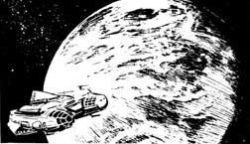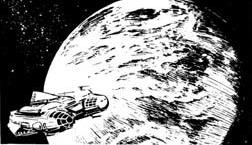Empress Marava class Far Trader
| Empress Marava class Far Trader | |
|---|---|
 | |
| Type: AF Far Trader | |
| Category | ACS |
| Size | 200 Tons |
| Hull Configuration | Close Structure Hull |
| Streamlining | Streamlined Hull |
| Tech Level | TL–10 |
| Engineering | |
| Computer | Model 1/bis |
| Jump | J-2 |
| Maneuver | 1 G |
| Fuel Treatment | Scoops, Intakes |
| Armaments | |
| Hardpoints | 2 |
| Accommodations | |
| Staterooms | 10 |
| Low Berths | 4 |
| Personnel | |
| Crew | 3 |
| High/Mid Passengers | 7 |
| Low Passengers | 4 |
| Payload | |
| Cargo | 61 Tons |
| Fuel tank | 44 Tons |
| Carried craft | Air/Raft |
| Construction | |
| Origin | Third Imperium |
| Year Operational | Unknown |
| End of Service | Still in active service. |
| Price | |
| Cost | MCr59 |
| Architect fee | MCr0.59 |
| Statistics | |
| Quick Ship Profile | AF-BS12 |
| Universal Ship Profile | AF-21211R1-000000-00000-0 |
| Images | |
| Blueprint | Yes |
| Illustration | Yes |
| Source | |
| Also see | Far Trader |
| Canon | Published, canon design |
| Designer | Marc Miller |
| Design System | Book 2, T5 |
| Era | 1105 |
| Reference | Starships 19. |
| Starships are designed with the Classic Traveller format, using High Guard, Book 2 and Traveller5. | |
The Empress Marava class Far Trader is a mercantile starship and one of many standard 200-ton Far Trader designs known to Charted Space.
- It is a civilian ship and a Far Trader.
Description[edit]
Using a 200-ton, TL–10 hull, the Empress Marava class Far Trader ranges far and wide, and deals with every world it finds. Even amber zones and red zones are not considered off limits by its captains, provided there is profit to be made and the risk of being caught is slight.
It is capable of 1-G acceleration and jump-2. Fuel tankage supports jump-2 and one month of operation, and the ship incorporates fuel scoops and intakes for wilderness refueling. The bridge is standard and has a computer Model/1bis installed. There are two hardpoints, but no weapons are mounted. The ship has ten staterooms (three for the crew; seven for the passengers) and four low berths. A single air/raft is carried (in a fitted hull compartment) for various surface duties. The ship is streamlined, and can land on uneven terrain. Cargo capacity is 61 tons, plus a one ton mail vault.
The far trader requires a crew of three: pilot/astrogator, engineer, and steward. It costs MCr 59 (including fees and the 10% discount for standard designs). [1]
Dimensions: 49.3 meters long by 28.5 meters wide by 8.7 meters high. [2]
Image Repository[edit]
- A prototypical Far Trader.

Basic Ship Characteristics[edit]
Following the Imperial Navy and IISS Universal Ship Profile and data, additional information is presented in the format shown here. The small craft factor indicates the number of squadrons (...of ten subcraft) carried on the ship. Tonnage on the universal ship profile is shown in kilotons (...thousands of tons) where necessary. [3]
| Basic Ship Characteristics [3] | ||
|---|---|---|
| No. | Category | Remarks |
| 1. | Tonnage / Hull | 200 tons.
|
| 2. | Crew | Crew: Three. Pilot/navigator, engineer, and steward/medic. In addition, two gunners may be carried as needed. [2] |
| 3. | Performance | Propulsion:
Acceleration: 1-G. Normal operations and cruising at 1-G. [2]
|
| 4. | Electronics | x1 Model/1 bis ship computer.
|
| 5. | Hardpoints | x2 hardpoints. |
| 6. | Armament | Armament: Port and starboard hardpoints, each with a dual laser turret standard. Optional weaponry available. [2] |
| 7. | Defenses | No Defensive equipment is normally instealed except for evasion software. |
| 8. | Craft | Ship's Boats: No auxiliary vessels. One four-passenger air/raft carried over the forward cargo loading ramp with interior boarding and access. Used for errands and has limited sub orbital capability. [2] |
| 9. | Fuel Treatment | The ship incorporates fuel scoops for gas giant skimming. |
| 10. | Cost | MCr 66.175. |
| 11. | Construction Time | 8 months. |
| 12. | Comments | Other Equipment:
|
History & Background[edit]
The Far Trader[edit]
The far trader ranges far and wide, and deals with every world it finds. Even amber zones and red zones are not considered off limits by its captains, provided there is profit to be made and the risk of being caught is slight. [4]
THE FAR TRADER: The basic ship involved in free trade is called the free trader. Variations on the basic ship have resulted in variations in the name. The subsidized merchant, partly because of its size, and partly because of its subsidy, is called the fat trader. Some well-equipped high-G traders employed beyond the Imperial border are called fast traders. The type A2 far trader derives its name from its jump capability: its drives are capable of Jump-2, twice what the standard free trader can do. The far trader can be encountered anywhere in the Imperium. It ranges far and wide, and deals with every world it finds. Even amber zones and red zones are not considered off limits by its captains, provided there is profit to be made and the risk of being caught is slight. [1]
The Empress Marava Name and Lineage[edit]
Empress Marava was born on Kaskii, and there was a great deal of excitement about it there during her short reign as one of the many Emperors of the Flag. A small and struggling starship architecture firm on Kaskii called Bilitig und Dottir commemorated Marava’s rise to power with the design of the Empress Marava Class. Bilitig und Dottir banked its entire firm on the project and went bankrupt when a second run failed to materialise the interest of the first following Marava's defeat. However, with the ascent of Arbellatra to the role of Regent, the Empress Marava-class found a solid market. Its specifications were made available as open source, and several starship-construction companies began to manufacture it.
Class Naming Practice/s & Peculiarities[edit]
The design of the far trader has ship security in mind, and so all passengers are segregated onto a passenger deck. Their access to the bridge and to other areas of the ship is limited. Unfortunately, when a seventh passenger is carried, he or she is berthed adjacent to the bridge. Original specifications did not envision more than six passengers, but the profit motive has led to them being overridden. [5]
Selected Variant Types & Classes[edit]
56 Representative Free Trader (AF) Classes[edit]
References[edit]
| This article has metadata. |

|
This ship was originally designed using one of the Classic Traveller ship design rules:
|

|
This ship was originally designed using GURPS Traveller ship design rules.
|
This ship was originally designed using Mongoose Traveller (1st Edition) ship design rules.
|

|
This ship was originally designed using Traveller 5th edition ship design rules.
|
- Marc Miller. Traders and Gunboats (Game Designers Workshop, 1980), 23-26.
- Rob Caswell, William W. Connors, Joe Fugate, Gary L. Thomas. Starship Operator's Manual (Digest Group Publications, 1988), 58.
- Anonymous. SGS: Subsidized Merchant (Seeker Gaming Systems, 1990), TBD.
- TBD. SGS: Empress Marava (Seeker Gaming Systems, 1990), TBD.
- Joe Fugate. MegaTraveller Journal 4 (Digest Group Publications, 1993), TBD.
- Dave Nilsen. The Regency Sourcebook (Game Designers Workshop, 1995), 86.
- Loren Wiseman. GURPS Traveller Core Rules (Steve Jackson Games, 1998), 135.
- Steve Daniels, Jim McLean, Christopher Thrash. Far Trader (Steve Jackson Games, 1999), 110-111.
- James Miller. Type A Far Trader "HIMS Easy Money" (Scrying Eye Games, 2012), 1.
- Michael Johnson. A2L Far Trader (Moon Toad Publishing, 2015), .
- Michael Johnson. Type A Free Trader (Moon Toad Publishing, 2015), .
- Matthew Sprange. High Guard (Mongoose Publishing, 2016), 116.
- Tom Mouat, Ian Stead. Traveller Ship Font (Moon Toad Publishing, 2019), 1.
- Adrian Tymes, Sabrina Tymes, Gabriel G. A. B. Fonseca, Robert Eaglestone. Starship Operator's Manual (Mongoose Publishing, 2024), 137.
- ↑ Jump up to: 1.0 1.1 Marc Miller. Traders and Gunboats (Game Designers Workshop, 1980), 23.
- ↑ Jump up to: 2.00 2.01 2.02 2.03 2.04 2.05 2.06 2.07 2.08 2.09 2.10 2.11 Marc Miller. Traders and Gunboats (Game Designers Workshop, 1980), 24.
- ↑ Jump up to: 3.0 3.1 Timothy B. Brown. Fighting Ships (Game Designers Workshop, 1981), 10.
- ↑ Marc Miller. "Starship Design and Construction." T5 Core Rules (2013): 358.
- ↑ Marc Miller. Traders and Gunboats (Game Designers Workshop, 1980), 26.